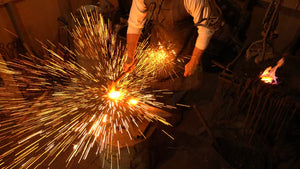
The world is changing. It always has been. But is there anything that has stayed the same, withheld the test of time, anything that isn't outdated? So much of the world we live in today is new. Cars, planes, indoor heating and cooling—everything we take for granted. But there is one thing that has outlasted every trend, development, and change. What is it? Knives. When you take a look back at man's history, knives and blades are strewn across progress's timeline. From our earliest ancestors to the current generation, knives have fluctuated in their popularity, but have never gone out of use.
From the earliest point of recorded history, there has been use for knives or some sort of sharpened object. Hunting, fishing, cooking, and many other basic activities used to survive are difficult—if not impossible—without tools to aid in the process. Sharpened objects were one of the first tools to be crafted by mankind, which proves the fact that they could never be replaced. In addition to survival tactics, blades were irreplaceable as self protection tools against attacks from animals or rival people groups.

Flint blade - source: cowanauctions.com
When exactly did the crafting of the earliest blades start? We can trace this back to the Stone Age, which is classified as the first time in which people began using stone as a tool. Flint or stone was chipped to create an edge suitable to saw, cut, or slice materials. This age was followed by the Copper and Bronze ages, marking the first time humans used metal for tools. During these times, the discovery of how to process and shape metal to make tools became widely known, thus leading to the invention of metal knives, closer to what we know today.
The Bronze age began with the discovery of combining tin and copper to make bronze. It is believed that the Sumerian Civilization was the first people group to make this discovery. The Iron age came directly after, and with it a new standard—better and more easily crafted tools. Iron proved all other materials insufficient for the growing needs of society.

Bayonet - source: emuseum.history.org
Among other wars and events, the American Revolution is one we can look to for visible change. Weapons used during the Revolutionary War included muskets, rifles, and pistols. However, muskets—the most commonly used weapon—often proved untrue in their aim. During this time, bayonets came into popular use. Bayonets were triangular shaped blades fashioned to fit onto the tip of a musket, for use in close combat. Use of the tomahawk was also seen during this war. The tomahawk was used by Native Americans for hand to hand fighting, and could also be thrown at opponents.
Another period in history that was instrumental in the background of knives was the rise of the Fur Trading industry in the 19th century. The Rocky Mountain fur trade reached its peak during the years of 1820-1840, creating new needs for different tools. Some animals commonly sought after in this period included beaver, deer, otter, muskrat, and many others. The need for tools changed drastically during this time, yielding more specialized blades for skinning such animals as were popular. Events and periods like this are the primary reason for the diversity we see in blades today. With more and more people migrating to the popular areas of the United States, this era in history was significant in creating relationships between different ethnic groups such as English, Dutch, Native American, and many others.

Trench knife - source: auctionzip.com
Advancing in history, the 20th century is another time period to look to for viewing the changes in blades. In the Civil War, bayonets were used as well as cavalry sabers. Cavalry sabers were long, cumbersome and weighty swords, carried most by cavalrymen. In WWI, new weapons were introduced, beginning more modern warfare tactics. While bayonets were still used, trench knives were then introduced, combining a smaller triangular blade with a specialized knuckle guard to prevent the user from dropping the knife during a struggle. In WWII, the ka-bar came into use first in November 1942, by the United States Marine Corps. Another blade that came into light during this period was the V-42 stiletto, used by an American/Canadian commando unit.

Wakizashi - source: worthingtongalleries.com
So far, we have mostly focused on American blades. However, America is only a small part of what influenced different knives and blades across the years. Take the Wakizashi blade, for instance. The wakizashi was first invented in Japan and used by Samurai as far back as the 15th century. It was a staple on every warrior, providing a backup weapon when a katana fell short. The Samurai's use for a wakizashi is comparable to that of a pistol in modern day warfare. This example is only one in many different countries and cultures of blades, that combine to create a fascinating history.
From kitchen use to bushcraft tools to everyday carry, knives are still used daily by most people around the globe. Knives, in addition to being tools, have also become somewhat of an artform. Stunning and bold designs can be seen more and more, though not necessarily meant for use. These knives are created to be enjoyed as one would enjoy a painting—displayed in your home or kept away to add to your collection.
Though this is only an abbreviated account of some of the blades throughout history, it serves to show that knives have always and will always be a crucial part of humanity as we know it. Take a moment to imagine a world without blades of some sort—it's difficult, isn't it? Knives are one of the pillars of ancient and modern tools that have helped to form what the world is today.
Author: S. J. Mett
Sources used:
“3 Major Periods of Metal Age: Copper, Bronze and Iron Age.” Your Article Library, 9 June 2014, https://www.yourarticlelibrary.com/essay/anthropology/3-major-periods-of-metal-age-copper-bronze-and-iron-age/41651.
Author, TKH. “The History of the Knife throughout the Ages.” The Knife Hub, 15 Apr. 2020, https://www.theknifehub.com/history-of-knives/.
“A Brief History of the Fur Trade.” History Colorado, https://www.historycolorado.org/brief-history-fur-trade.
A History of Knives Past and Present - Youtube. https://www.youtube.com/watch?v=m47H2NhWaRk.
“History of Knives: A Brief Look at a Sharp Subject.” Exquisite Knives, 17 June 2021, https://exquisiteknives.com/history-knives/.
History.com Editors. “Bronze Age.” History.com, A&E Television Networks, 2 Jan. 2018, https://www.history.com/topics/pre-history/bronze-age.
History.com Editors. “Stone Age.” History.com, A&E Television Networks, 12 Jan. 2018, https://www.history.com/topics/pre-history/stone-age.
“List of World War II Weapons of the United States.” Wikipedia, Wikimedia Foundation, 28 Apr. 2022, https://en.wikipedia.org/wiki/List_of_World_War_II_weapons_of_the_United_States.
“Mark I Trench Knife.” Wikipedia, Wikimedia Foundation, 19 Aug. 2021, https://en.wikipedia.org/wiki/Mark_I_trench_knife.
Msw, and Msw. “Knives, Swords, and Daggers – to c. 1500 C.E.” Weapons and Warfare, 29 Nov. 2015, https://weaponsandwarfare.com/2015/11/01/knives-swords-and-daggers-to-c-1500-c-e/.
“Weapons of the Civil War.” NCpedia, https://www.ncpedia.org/weapons-civil-war.
“Weapons Used during the Civil War [with Photos].” Middle Creek, 22 May 2020, https://www.middlecreek.org/civil-war-weapons/.
“World War One - Weapons.” History, 14 Oct. 2020, https://www.historyonthenet.com/world-war-one-weapons.
Yost, Author Russell. “Weapons from the Revolutionary War.” The History Junkie, 26 Apr. 2020, https://thehistoryjunkie.com/weapons-from-the-revolutionary-war/.
Yost, Author Russell. “Weapons from the Revolutionary War.” The History Junkie, 27 Apr. 2022, https://thehistoryjunkie.com/weapons-from-the-revolutionary-war/.


